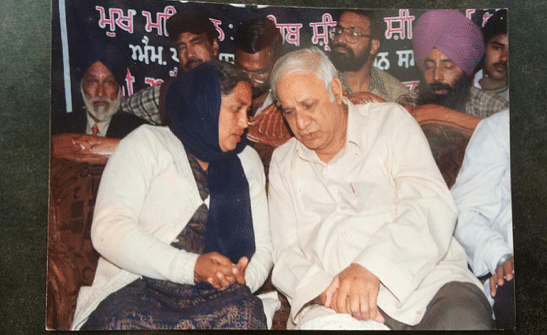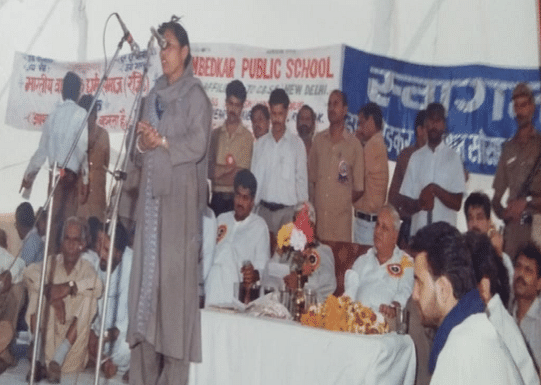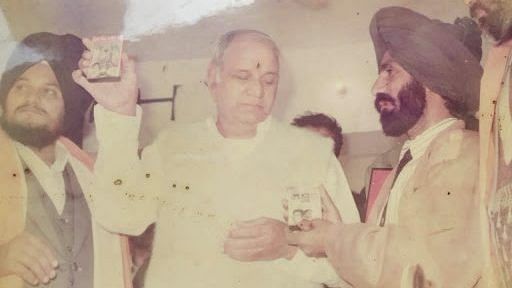Kanshi Ram, a charismatic Bahujan leader, believed that a society in which the non-political roots are not strong, is bound to fail in its political aspirations as well. It is easy to write off the Bahujan Samaj Party because of its recent political misfortunes, but it would be a grave error to look at Kanshi Ram’s Bahujan revolution as merely political. The bedrock of all his meetings and mobilisations was a cultural revival.
Kanshi Ram’s Hegelian premise of raising rational consciousness among Bahujans can well be drawn from his efforts towards debunking Brahminism and raising anti-caste awareness through everyday practices. So, Kanshi Ram Jayanti, which falls on 15 March, holds a special place among those who identify themselves as Bahujan. Its celebration becomes a reminder of the shared cultural-political history of being part of the Bahujan movement that began in the 1980s.
This cultural re-imagination was present in BAMCEF (All India Backward and Minority Communities Employees Federation), DS4 (Dalit Shoshit Samaj Sangharsh Samiti) and BRC (Buddhist Research Center).
Also read: Why Ambedkar chose Buddhism over Hinduism, Islam, Christianity
The three pillars
BAMCEF, DS4, and BRC can be considered the three cultural pillars holding up the Bahujan movement. Kanshi Ram, in one of his interviews, said that while the Bahujan Samaj Party (BSP) was aimed towards political gratification, the other three were the most important vehicles to achieve it (Collected Interviews of Kanshi Ram).
The manifesto of BAMCEF had specifically called for creating a literary wing to bring together different thought processes. An engagement with the Bahujan literary tradition was an attempt to understand the social history and the experiential reality of the Bahujan community as well. Similarly, the manifesto also discussed the creation of Jagriti Jatha to raise anti-caste consciousness among Bahujans.
In BAMCEF meetings, cultural presentation was an integral part and it included displaying posters, musical performances, and poetry recitation. One of the earliest BAMCEF meetings in Delhi’s Shahdara on 17 May 1980 was themed as Chalta Firta Ambedkar Mela, which involved an art gallery displaying the life and philosophy of Dr Ambedkar. Kanshi Ram’s practice of the carnivalesque weaved together Bahujan masses at both individual and collective levels. The early BAMCEF participants still recall the collective memory of participating in different BAMCEF meetings.
Harvinder Kaur recalls her association, “My memory with BAMCEF is as old as when I was 14 years old. I had participated in the third BAMCEF meeting at Chandigarh and sang a Punjabi song dedicated to the mission.” Similarly, a Bahujan singer Taranum Baudh recalled singing her first song on the BAMCEF platform when she was barely three years old. Residents of Punjab, Harnam Singh Bahelpuri and Poonam Bala, were closely associated with singing and had also performed during several BAMCEF meetings convened by Kanshi Ram. Kanshi Ram himself had released cassettes of many of these singers.
The Dalit Shoshit Samaj Sangharsh Samiti, or DS4, was launched on 6 December 1981. It laid particular emphasis on the struggles of students, youth, and women. This cultural wing started from Punjab and spread to several states in north India including Haryana, Himachal Pradesh, and Uttar Pradesh. Kanshi Ram started DS4 with the aim of giving Bahujans a platform to share their anti-caste consciousness. In one of the editorials of The Oppressed Indian, 1982, Kanshi Ram said that DS4 is one of the foremost steps to organise 85 per cent of Bahujan voters and prepare them for politics so that they can take up leadership roles.
Buddhist Research Centre, or BRC, was also established by Kanshi Ram and he was ever willing to take up Buddhism. In 2003, Kanshi Ram had announced that he along with his protege Mayawati would convert to Buddhism in 2006, the year that marked the golden jubilee of Ambedkar’s conversion. He had also said that the conversion of people from the Chamar community In Uttar Pradesh and Madhya Pradesh alone will create three crore Buddhists in India (Bahujan Sanghtak, 2003).
However, after his death on 9 October 2006, his vision for mass conversion was never taken up by Mayawati. Nor did the BSP put up a collective effort towards working on the cultural front as was done by Kanshi Ram. Many of the singers and cultural artistes today have been forgotten in the absence of any political support. Similarly, the population of Buddhists in Uttar Pradesh remains less than 1 per cent. While political power was something that Kanshi Ram always desired, he never ignored the power of culture and its forceful assertion, which Bahujans could do by converting to Buddhism and debunking casteist Brahminical practices, an important step towards breaking the established cultural hegemony.
Also read: This is why Dalit women are singing Tathagata Buddha songs in UP
Contemporary cultural practices of Bahujan
The Bahujan movement is still fresh in the minds of those who were associated with Kanshi Ram through BAMCEF, DS4, BRC, or BSP. They recall even the smallest memories they have of meeting Saheb or his visit to their houses to share a meal. The charismatic leader is graciously remembered by them every 15 March.
In north India, the modern anti-caste struggle goes back to Swami Achyutananda, B.A. Santram, Chandrika Prasad Jigyasu, Jagdeo Prasad, Lalai Singh Yadav, Mangu Ram, and many others. While the intellectual wave generated by them is worth appreciating, it was Kanshi Ram who translated the Bahujan idea into popular imagination. Kanshi Ram’s personality was such that he instantly connected with the masses, particularly Bahujan women. There were several women who led Kanshi Ram’s Bahujan struggle, but they are hardly known today. But Kanshi Ram knew the importance of everyone who was associated with the movement. He would often visit the homes of cadre members, stay with them and have long conversations. It won’t be an exaggeration to call him a bottom-up leader who had a dynamic relationship with the masses. He was a mass leader in the true sense.


Besides political milestones, Kanshi Ram had an important role in reviving the socio-cultural icons in north India. Kanshi Ram Jayanti is marked by paying reverence to Dalit-Bahujan icons like Jyotiba Phule, Savitri Bai Phule, Dr Ambedkar, Sahuji Maharaj, Fatima Sheikh, Birsa Munda, and Periyar E.V. Ramasamy to mention a few. It is done by circulating their images, wall-art, calendar prints, pamphlets, etc.
The occasion also sees a carnival organised by different groups. It involves a discussion on Kanshi Ram’s thoughts and struggle, cultural performances like plays, songs and poetry recitation, circulation of popular prints and pamphlets, sloganeering, and taking out marches.
This annual carnival is one of the many ways through which the Bahujan society remains connected today, sharing each other’s thoughts, passing on their individual experiences of fighting the anti-caste struggle. This carnival is a new space for the emergence of a counter-culture. Russian philosopher Mikhail Bakhtin’s carnivalesque discussed the importance of cultural spaces like carnivals in the Renaissance. The Bahujan carnival, like Kanshi Ram Jayanti, is also a new space for anti-caste imagination, which seeks to assert its claim on dignity and equality.
Also read: Not just Mayawati, these are the unsung women who led Kanshiram’s Bahujan struggle
Kanshi Ram Jayanti’s meaning and its cultural prospects
Kanshi Ram’s Jayanti means an anti-caste worldview for the Dalit-Bahujan. It is the day of remembrance of Saheb’s struggle to claim political consciousness and uproot caste practices from the public sphere.
Interestingly, the conceptual category like Bahujan has brought together different caste-based oppressed identities together. The idea of Bahujan is culturally rooted. This Bahujanhood marks its visibility through celebrating Bahujan icons, discussing historical gaps and absences, musical re-imagination, etc.
The music industry has engaged with Kanshi Ram through songs like Kanshi Ram Saheb Ka Alha sung by Seema Azad. Her song brings out the life history of Kanshi Ram through the Alha genre of music, which is popular in regions of Uttar Pradesh. Other songs include The Great Leader Kanshi Ram by Raju Bharti and Manywar Kanshi Ram Saheb Ki Yaad Mein by Malti Rao. Publication houses like Samyak Prakashan, which was started by Shanti Swaroop Baudh, have played an important role in popularising Kanshi Ram’s ideas. Similarly, there has been an effort by activists like A.R. Akela to put together Kanshi Ram’s speeches and bring them out through his home-grown publication Anand Sahitya Sadan in Aligarh.
Each of these cultural facets displayed in events like Kanshi Ram Jayanti has played a significant role in assembling the collective memories of Bahujan. The Bahujan movement started by Kanshi Ram was a well-structured plan that spread into social, cultural, and political spheres. Even though in recent times, the Bahujan movement has reflected political fragility, the idea of Bahujan remains alive with fresh life being breathed into it by members both on the ground and on social media. It has all the potential to return to the political sphere with the same zeal and fervour because of the sentimentality involved in the Bahujan movement, borne out of people’s life-long struggle against oppression. Kanshi Ram’s vision of engaging with cultural parameters so that people are emotionally attached to the movement gives him a unique position as a Bahujan leader in India’s socio-political firmament.
Kalyani is a PhD scholar at the Center for the Study of Social Systems, Jawaharlal Nehru University. She tweets at @FiercelyBahujan. Views are personal.







BEHENJI should join forces with BJP against anti HINDU proselytizing forces.
Remember what has happened to Dalits in pakistan.
And BEHENJI now imagine dalits are in minority in INDIA and majority is the same as in pakistan .
Please understand all HINDUS should stand together to create a scientifically educated society. A society which is not violent but ready to defend itself.